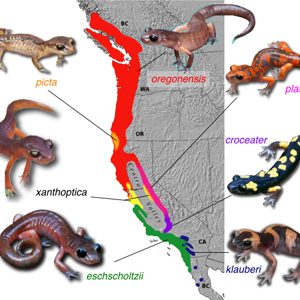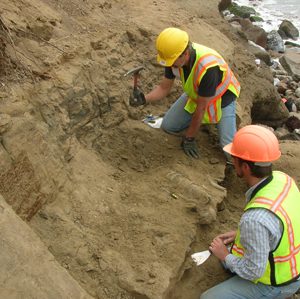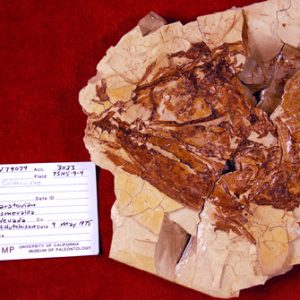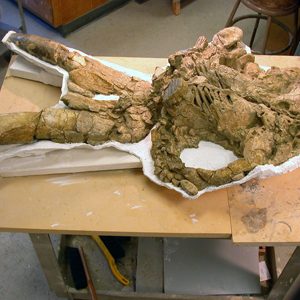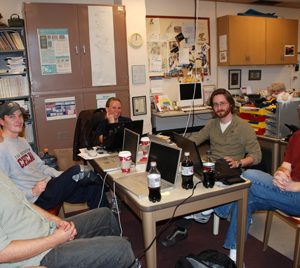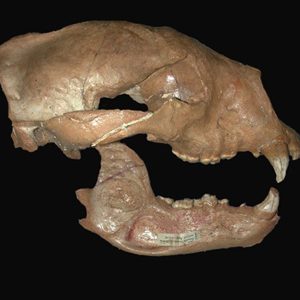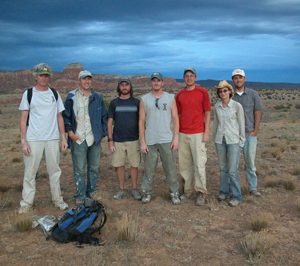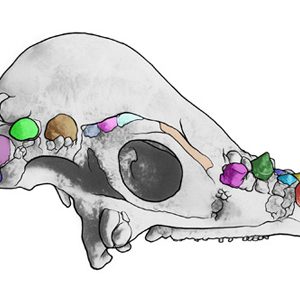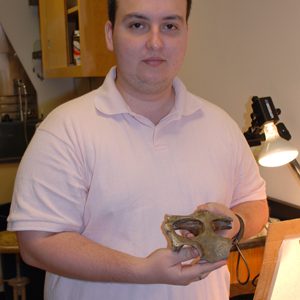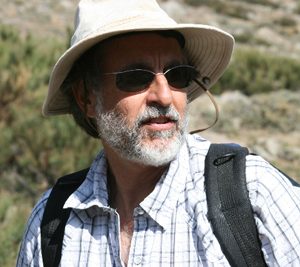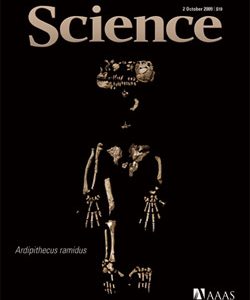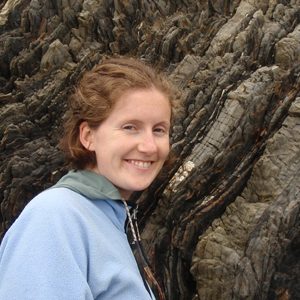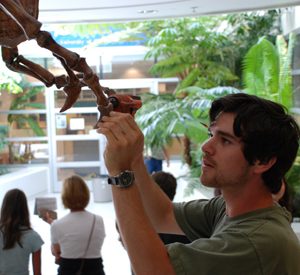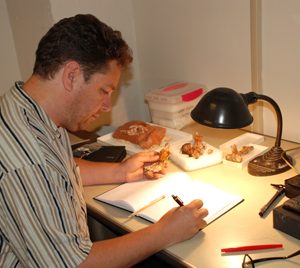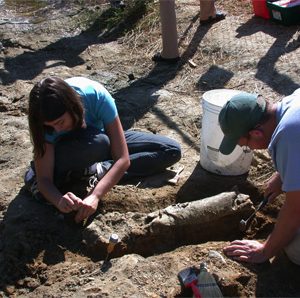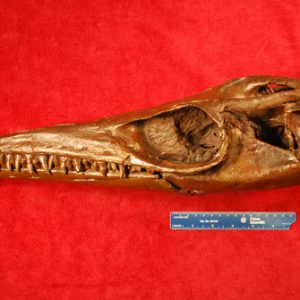Ring species are often touted as examples of speciation in action — and the Ensatina salamander, which forms a ring around California's Central Valley, is a classic example. Biologists discovered this ring species back in the 1950s, and investigations of Ensatina continue today. Learn more about Ensatina in this research profile of biologist Tom Devitt, on the UCMP's Understanding Evolution website. Tom is a graduate student in Integrative Biology here at UC Berkeley. The profile follows him … [Read more...] about Highlights from Understanding Evolution
vertebrates
Fossils found fortuitously
Not all fossils are discovered by paleontologists combing the earth on special expeditions. Many fossils are found by accident — particularly during construction projects. Impressive fossils, like whales, mammoths, and sloths, have been found while digging foundations for buildings, leveling land for highways, and excavating subway tunnels. This spring, the UCMP blog will take you on a tour of Bay Area construction sites, past and present, to show you some of the fossils underfoot in the … [Read more...] about Fossils found fortuitously
Fish in the UCMP
It is pretty unusual to see fish in the UCMP. It’s not that we don’t have any fish specimens — we have over a million fossilized fish fragments. It’s just that none of our museum scientists focus on fish, and so the museum’s fish parts tend to stay in the cabinets. But this past summer, Ralph Stearley of Calvin College visited the UCMP, and he did a little fishing. Ralph pulled some spectacular specimens from the murky depths of the cabinets. The two specimens shown here are exceptional — … [Read more...] about Fish in the UCMP
Lupé’s story, part 2: Prototyping the mammoth exhibit
UCMP graduate student Kaitlin Maguire is working with the Children’s Discovery Museum in San Jose to develop a new exhibit about the life of Lupé, a mammoth fossil that was found in the nearby Guadalupe River. This is the second in a series of blogs about Lupé and the new exhibit. Read Kaitlin’s first Lupé blog here. Development of the Lupé Story Exhibition is moving along quickly as exhibit ideas come to life in prototyping labs, in which the development team at the Children’s Discovery … [Read more...] about Lupé’s story, part 2: Prototyping the mammoth exhibit
Collaborating, with the help of the collections
A few weeks ago, we blogged about the discovery of a new species of dinosaur, Tawa hallae. Two UCMP alums, Sterling Nesbitt and Randy Irmis, described this new dino in the journal Science. A few weeks ago, Sterling, Randy, and two of their Tawa co-authors, Nate Smith and Alan Turner, visited the UCMP. They've come from Texas, Utah, Illinois, and New York, to work together and delve into the UCMP's collections. Along with UCMP Faculty Curator Kevin Padian and graduate student Sarah Werning, they … [Read more...] about Collaborating, with the help of the collections
Fossils provide baseline for mammal diversity
As more and more species go extinct, biologists wonder whether we are on the verge of the earth's sixth mass extinction. A new study, by Marc Carrasco and Tony Barnosky of the UCMP and Russell Graham of Pennsylvania State University, uses the fossil record to examine mammal biodiversity in North America over the past 30 million years. Carrasco and his collaborators used data from two fossil databases, MioMap and Faunmap, to determine the baseline of mammal diversity before humans arrived in … [Read more...] about Fossils provide baseline for mammal diversity
New dino described by UCMP alums
Last week, two University of California Museum of Paleontology alums, Sterling Nesbitt and Randall Irmis, described a new species of dinosaur in the journal Science. The new species, Tawa hallae, sheds light on early dinosaur evolution — and the importance of the UCMP's collections. Tawa's bones were first found by hikers in Ghost Ranch, New Mexico, in 2004. Around that time, Sterling and Randy were doing fieldwork at the nearby Petrified Forest National Park in northern Arizona, excavating … [Read more...] about New dino described by UCMP alums
Paleo Video: A modern day dinosaur extinction
During the Cretaceous, dome-headed pachycephalosaurs roamed through what is now the Hell Creek Formation, covering parts of Montana, Wyoming, and North and South Dakota. But UCMP Curator Mark Goodwin and Museum of the Rockies Curator Jack Horner argue that there were fewer pachycephalosaur species than we thought. Mark and Jack suggest that two species, Dracorex hogwartsia and Stygimoloch spinifer, are actually juveniles and teenagers of the species Pachycephalosaurus wyomingensis. Learn about … [Read more...] about Paleo Video: A modern day dinosaur extinction
South American crocodilians
Daniel Fortier visited the UCMP for two weeks this summer, investigating the taxonomy of South American crocodilians — crocodiles, caymans, and gharials. Daniel is from Brazil, where crocodiles are fairly common. He is a Ph.D. student at the Universidade Federal Do Rio Grande Do Sul in Porto Alegre, and is spending the year at the University of Iowa, in Iowa City. He is using fossils and modern skeletal materials to learn about crocodilian evolutionary history, places of origin, dispersal … [Read more...] about South American crocodilians
UCMP’s Tony Barnosky in The Economist
Check out this week's issue of The Economist — it features the work of UCMP Faculty Curator Tony Barnosky. Tony looks at how climate change affects the ecology and distribution of mammals — in the distant past and in the future. The UCMP last blogged about Tony's work here. … [Read more...] about UCMP’s Tony Barnosky in The Economist
Human evolution in the headlines
This week's big paleo story centers on Ardipithecus ramidus, a species of hominid that lived in the woodlands of Ethiopia, 4.4 million years ago. UCMP Faculty Curator and Human Evolution Research Center (HERC) director Tim White is co-director of the Middle Awash Project, the team of researchers that excavated and studied the fossils. The team includes UCMP Faculty Curator and HERC Associate Faculty member Leslea Hlusko. Find out more about the discovery: Science magazine has 11 papers … [Read more...] about Human evolution in the headlines
Paleo Video: Kaitlin Maguire at the John Day Fossil Beds
Watch this video and join UCMP graduate student Kaitlin Maguire on a field trip to the John Day Fossil Beds National Monument! After visiting the park last spring, Kaitlin decided it's the perfect place to do her dissertation research. "When you do a field project for paleontology, especially if you're looking for fossils, you never know what you're going to find — you never know if there's going to be enough data," says Kaitlin. But paleontologists from the UCMP and elsewhere have been … [Read more...] about Paleo Video: Kaitlin Maguire at the John Day Fossil Beds
T. rex gets a manicure
A few months ago, the UCMP’s Tyrannosaurus rex broke a nail. The right claw mysteriously went missing. We needed to replace it, but obviously the standard-issue drugstore press-on nail just wouldn’t do. We had to re-construct a new right claw by making a copy of the intact left claw. Danny Anduza, a UCMP volunteer, carried out the claw restoration. First, he mixed up a rubbery substance and painted it over the T. rex’s left claw, to make a mold. Once the rubber hardened, he carefully sliced it … [Read more...] about T. rex gets a manicure
Super-sized sinuses
David Dufeau, a graduate student from Ohio University, spent a few days at the UCMP this July, studying the development and evolution of the middle-ear sinuses in archosaurs — birds and crocodilians. He explains that the sinuses in these animals were so greatly expanded that they completely surrounded the braincase. By understanding these super-sized sinuses in the archosaurs, David hopes to infer something about the nature of auditory receptivity. Maybe the sinuses expanded as adaptations … [Read more...] about Super-sized sinuses
Lupé’s story: A mammoth’s journey from the ground to a museum
In 2005, Roger Castillo found the fossilized bones of a juvenile mammoth in the Guadalupe River near San Jose. Roger was walking his dog along the river, which he did frequently as a volunteer for the Guadalupe-Coyote Resource Conservation District, when he saw the tusks of the mammoth's skull poking out of the soil along the riverbank. At the time he wasn't exactly sure what he was looking at but recognized their importance and contacted the UCMP. The fossilized mammoth has been named Lupé, … [Read more...] about Lupé’s story: A mammoth’s journey from the ground to a museum
Meet a mosasaur
Imagine you are driving down I-5, just north of Bakersfield, in California’s hot and dusty central valley. Except that it’s the Cretaceous Period, 80-65 million years ago, and the central valley is actually an inland sea. And instead of seeing cows standing by the side of the highway, you see mosasaurs swimming through the salty water. Mosasaurs were marine reptiles that lived during the late Cretaceous, in oceans all over the world. They had fins on their long bodies, and sharp teeth in their … [Read more...] about Meet a mosasaur
